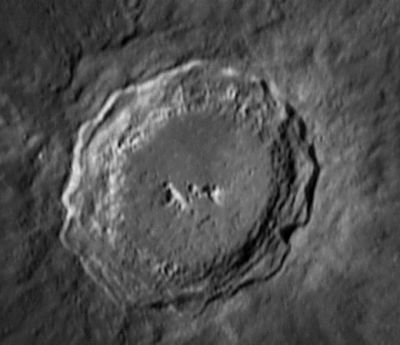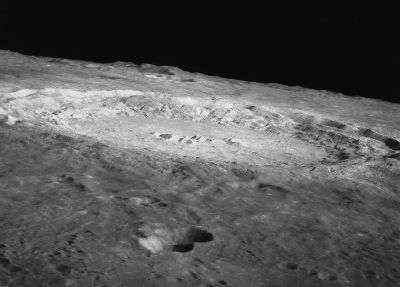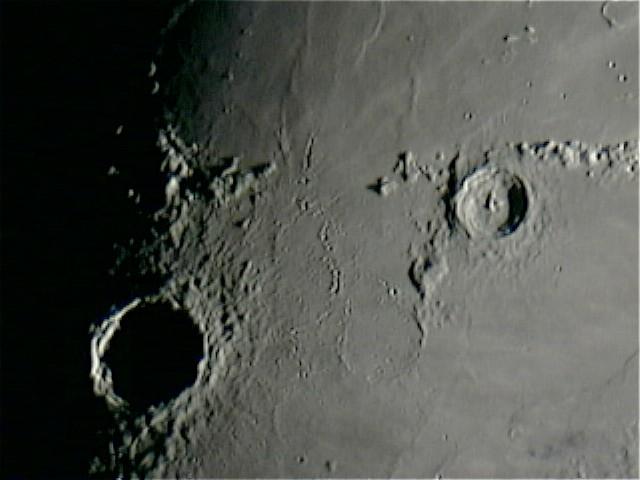Copernicus
Contents
Copernicus - the Monarch of the Moon
|
Lat: 9.7°N, Long: 20.1°W, Diam: 93 km, Depth: 3.8 km, Rukl: 31, Copernican |


Left: Mick Hyde, Right: Apollo 12 AS12-52-7739 submitted by Stefan Lammel
Images
LPOD Photo Gallery Lunar Orbiter Images Apollo ImagesKaguya HDTV
- AS15-M-2589 and its preceding and following photographs in Apollo 15's MAGAZINE REV-71 show Copernicus near the curved horizon. Because the sun was too high at the moment of photography, there were no shadows in and around the crater.
- AS12-47-6875 and the almost identical looking AS12-47-6876 are two of the most frequently reproduced orbital Hasselblads of Copernicus (near the curved horizon) and Reinhold (in the foreground).
- The so-called "Picture of the Century" (Copernicus's cluster of central peaks and its northern inner slopes, photographed by Lunar Orbiter 2), was included on pages 231-232-233 in the NATIONAL GEOGRAPHIC of february 1969 (AWESOME VIEWS OF THE FORBIDDING MOONSCAPE; a nine-page portfolio). And on page 244 of the same issue, there's a remarkable detailed close-up of Copernicus's floor, made by Lunar Orbiter 5 (see LO-5150 to LO-5157).
- One of Chesley Bonestell's extraordinary paintings shows crater Copernicus with four astronauts on its southern rim. This painting was inspired by the so-called "Picture of the Century" (see description above). Bonestell's painting of Copernicus is online in one of Fabio Femino's Fantascienza-pages. See: Paesaggio Lunare (the fifth painting on that page).
- Another one of Chesley Bonestell's Copernicus-paintings was printed in Willy Ley's book The Conquest of Space (1951). This painting shows the floor of Copernicus as seen from a high summit on its eastern wall. In the Dutch translation of this book (De Sprong in het Heelal, 1951) this painting was printed as Plate XXIVa, between pages 38 and 39.
- Lunar Orbiter 5's Frame 148 shows a close-up of the dark-halo craterlet Copernicus H (southeast of Copernicus itself).
Research photographs and paintings: Danny Caes

Image submitted by ketil
Maps
(LAC zone 58A3) LAC map Geologic map LRO LOLA Topo Map (See 4.30.2010)
USGS Geologic Map of Crater Copernicus's interior floor and central peak system (I-840)
Description
The most well-known and most observed and photographed surface formation on the moon's near side. No wonder most lunar observers call it "The Monarch of the Moon". - DannyCaes Feb 16, 2014
Description: Elger
(IAU Directions) COPERNICUS.--This is without question the grandest object, not only on the second Quadrant, but on the whole visible superficies of the moon. It undoubtedly owes its supremacy partly to its comparative isolation on the surface of a vast plain, where there are no neighbouring formations to vie with it in size and magnificence, but partly also to its favourable position, which is such, that, though not central, is sufficiently removed from the limb to allow all its manifold details to be critically examined without much foreshortening. There are some other formations, Langrenus and Petavius, for example, which, if they were equally well situated, would probably be fully as striking; but, as we see it Copernicus is par excellence the monarch of the lunar ring-mountains. Schmidt remarks that this incomparable object combines nearly all the characteristics of the other ring-plains, and that careful study directed to its unequalled beauties and magnificent form is of much more value than that devoted to a hundred other objects of the same class. It is fully 56 miles in diameter, and, though generally described as nearly circular, exhibits very distinctly under high powers a polygonal outline, approximating very closely to an equilateral hexagon. There are, however, two sections of the crest of the border on the N.W. which are inflected slightly towards the centre, a peculiarity already noticed in the case of Eratosthenes. The walls, tolerably uniform in height, are surmounted by a great number of peaks, one of which on the E., according to Neison, stands 11,000 feet above the floor, and a second on the opposite side is nearly as high. Both the inner and outer slopes of this gigantic rampart are very broad, each being fully 10 miles in width. The outer slope, especially on the W., is a fine object at sunrise, when its rugged surface, traversed by deep gullies, is seen to the best advantage. The terraces and other features on the bright inner declivities on this side may be well observed when the sun's altitude is about 6 deg. Schmidt, whose measures differ from those of Neison, estimates the height of the wall on the W. to be 12,000 feet, and states that the interior slopes vary from 60 deg. to 50 deg. above, to from 10 deg. to 2 deg. at the base. The first inclination of 50 deg., and in some cases of 60 deg., is confined to the loftiest steep crests and to the flanks of the terraces. There are apparently five bright little mountains on the floor, the most westerly being rather the largest, and a great number of minute hillocks on the S.W. quarter. S.E. of the centre is a little crater, and on the same side of the interior a curious hook-shaped ridge, projecting from the foot of the wall, and extending nearly halfway across the floor. The region surrounding Copernicus is one of the most remarkable on the moon, being everywhere traversed by low ridges, enclosing irregular areas, which are covered with innumerable craterlets, hillocks, and other minute features, and by a labyrinth of bright streaks, extending for hundreds of miles on every side, and varying considerably both in width and brilliancy.
The notable crater-row on the E., often utilised by observers for testing the steadiness of the air and the definition of their telescopes, should be examined when it is on the morning terminator, at which time Webb's homely comparison, "a mole-run with holes in it," will be appreciated, and its evident connection with the W. side of Stadius clearly made out. There is another much more delicate row running closely parallel to this object; it lies a little E. of it, and extends farther in a northerly direction.
Description: Wikipedia
Additional Information
- Depth data from Kurt Fisher database
- Pike, 1976: 3.8 km
- Westfall, 2000: 3.8 km
- Viscardy, 1985: 3.76 km
- Cherrington, 1969: 3.84 km
- Measurements of crater topography using Kaguya laser altimeter terrain profile graphs.- LunarJim Jul 16, 2011
- Crater Depth: Measurements on 4 axes separated by 45 degrees.
- Zero reference level = Moon average radius.
- Average floor level (average of lowest levels on 4 axes) = -3.53km
- Average rim height (average of 8 rim data points) = +0.12km
- Average crater depth (average rim height to average floor level) = 3.65km
- Deepest point on crater floor (from zero reference level) = 3.56km
- Max. crater depth (highest point on rim to deepest point on crater floor) = 4.0km
- Central Peak Height (above average floor level) = 0.37km
- Main peak = 1.2 km (1174 m approx., - calculated) from shadows in LO Frame 4121 H2 using LTVT) - JohnMoore2
- West rim slope 52° (Pohn, 1963)
- Central peak composition: GNTA1, GNTA2 & AT (Tompkins & Pieters, 1999)
- Exterior impact melt deposits most extensive to NW, max of ~35 km beyond rim. Most extensive ejecta, rays and secondary craters to the NW, with max wall slumping on S side of crater, and topographically lowest rim crest to N & S (Hawke and Head, 1977).
- Copernicus and its satellite crater "H" are included in ALPO list of bright ray craters
- Copernicus H is a dark halo crater of Copernican age. See: Lunar Orbiter 5's Frame 148.
- During the mission of Apollo 17 in december 1972, crater Copernicus and its system of central peaks was photographed in earthlight. This happened when CSM America was directly above Copernicus, when the lunar sunrise-terminator was still too eastward. These earthlight photographs are included in Apollo 17's Magazine 158-WW (35mm NIKON B&W photographs), see: Sheet 8 of A17's Index Maps. Some of those photographs were reproduced in the Apollo 17 Preliminary Science Report. - DannyCaes Dec 22, 2007
- Copernicus: TSI = 35, CPI = 25, FI = 25; MI =75 Smith and Sanchez, 1973
- Copernicus H: TSI = 5, CPI = 5, FI = 5; MI =15 Smith and Sanchez, 1973
- Observer's note: when the sunrise terminator is located at Copernicus, exactly 24 hours later it will be at Sinus Iridum and the arc-shaped Montes Jura, thus creating the "Jewelled Handle effect" described by Sir Patrick Moore in his moonbooks. See also LPOD 24 Hours.
Lunar Ellipse of Fire
Copernicus C and D are (or were?) both number five in the list of 12 localities in the Lunar Ellipse of Fire (see article from Farouk El-Baz in Sky and Telescope - June 1973).
Nomenclature
- Nicolaus Copernicus (February 19, 1473 – May 24, 1543) was a European astronomer who formulated the first explicitly heliocentric model of the solar system. His epochal book, De revolutionibus orbium coelestium (On the Revolutions of the Celestial Spheres), is often conceived as the starting point of modern astronomy, as well as a central and defining epiphany in all the history of science.
- Called Carthusia (Chartreuse) by Gassendi in late 1630s [Whitaker: Mapping and Naming the Moon, p 33]. Perhaps the crater Copernicus reminded Gassendi of the walled Grande Chartreuse monastery in France. - tychocrater Jul 19, 2007
- It is a most interesting pastime to explore Johann Hewelcke's moonmap from 1647 (Figure Q, which shows his nomenclature). On this map, the crater which is nowadays officially known as Copernicus was called Mons Aetna (a well-known volcano), while the large nimbus of high-albedo ejectarays around it was called Cicilia. In fact, according to J.Hewelcke we are looking at a "lunar version" of that part of the terrestrial Mediterranean sea (the southwestern "extension" of Italy with Cicilia disconnected to it). - DannyCaes Mar 11, 2016
LPOD Articles
Superb Copernius!
Copernicus in Color
Lunar Addiction
Window with a View
Splayed Rays
A Great View of Copernicus
Copernicus in Color
Copernicus
WikiMoon
Compelling Copernican Color
Last Century's photo
A New Crater? (the bright ray-craterlet immediately west of Copernicus).
Concatenation
Lunar 100
L5: Archetypal large complex crater
Bibliography
- Yue, z. et al (2013). Projectile remnants in central peaks of lunar impact craters – Nature Geoscience | Letter, doi:10.1038/ngeo1828. Published online 26 May, 2013.
- Lucey, Paul G.; Hawke, B. R.; Horton, Keith (1991) The distribution of olivine in the crater Copernicus Geophysical Research Letters 18, Nov. p. 2133-2136.
- Pieters, C. M.; Adams, J. B.; Smith, M. O.; Mouginis-Mark, P. J.; Zisk, S. H. (1985) The nature of crater rays - The Copernicus example Journal of Geophysical Research 90, p. 12,393-12,413.
- Pieters, C. M.; Wilhelms, D. E. (1985) Origin of olivine at Copernicus Journal of Geophysical Research, Supplement 90, p. C415-C420.
- Pinet, P. C.; Chevrel, S. D.; Martin, P. (1993) Copernicus - A regional probe of the lunar interior Science 260, no. 5109, p. 797-801.
- Wood, C.A. Feb. 2001. Copernicus: a spellbinding crater. S&T Feb 2001 v101 p133
- Drawing and text of central peaks by Alika Herring. S&T March 1967, p. 187.
- APOLLO OVER THE MOON; A VIEW FROM ORBIT, Chapter 5: Craters (Part 5), Figure 164.